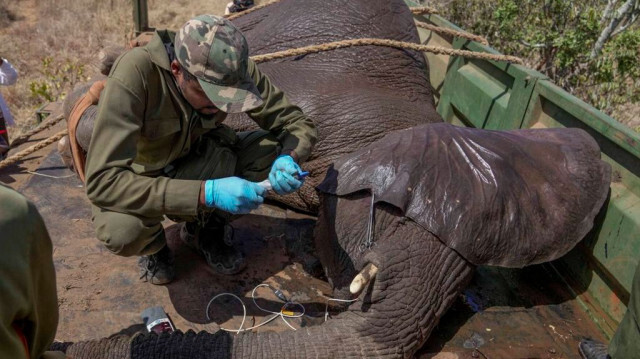
Kenyan authorities are expected to soon complete the transfer of dozens of elephants in the Mwea National Reserve to Aberdare National Park to protect humans and wildlife from escalating conflict as the tusker population booms
A delicate operation ensues on a cool morning under the careful supervision of Kenya's minister for tourism and wildlife.
The Kenya Wildlife Service (KWS) personnel are administering a sedative to calm elephants that are to be relocated, ensuring their safety.
A large crane is used to gently lift the elephants, which weigh between two and seven tons and have their legs securely harnessed into the waiting transport trucks.
Precision and care are crucial at this stage to minimize the stress that the animals endure during the move.
The operation is part of a broader exercise to transfer 50 elephants from Mwea National Reserve to Aberdare National Park — an ambitious move designed to address the pressing issue of human-wildlife conflict in central Kenya.
As the translocation nears completion, many communities in the area are welcoming the change, seeing it as a necessary solution to long-standing challenges.
The elephant populations in the Mwea National Reserve have experienced a notable boom in recent decades, rising from 49 in 1979 to an impressive 156 today, according to the KWS.
While the population growth is a conservation success, it has placed tremendous strain on the reserve's ecosystem, exceeding the habitat's carrying capacity and pushing the elephants to stray into surrounding farmlands.
- Conflict with local communities
It has led to increased instances of human-elephant conflict, with the animals raiding crops, damaging water tanks and destroying property, leaving local communities frustrated.
“Depopulating the area is a good thing,” said 64-year-old community elder Moses Wainaina Karanja. “The elephants raid our crops and destroy water tanks. Many of us depend on farming to survive, and the damage has been unbearable. In some instances, they even kill or injure us. I remember cases where people died and many others were injured.”
The view is shared by many in the Mwea region, where agriculture is the mainstay of the local economy.
With the elephants wandering out of the reserve in search of food and water, farms have suffered substantial losses.
The KWS has been working closely with communities to mitigate conflicts, but the scale of the problem requires a more permanent solution.
“The elephant translocations are complex but they offer immense long-term benefits,” said Tourism Minister Rebecca Miano. “By relocating elephants, we not only protect the animals and the communities they affect but also advance conservation and tourism.”
- Strained resources
The translocation is crucial not only for local communities but for the elephants, according to the KWS.
As their numbers grow, competition for resources within the reserve intensifies, leading to overgrazing and a depletion of available food and water.
By moving the elephants to Aberdare National Park, where there is more space and resources, the initiative is expected to ease the pressure and ensure the long-term health of the elephants and the environment.
In addition to reducing conflict, the translocation is expected to yield other important conservation benefits. “This operation will enhance genetic diversity and strengthen vulnerable elephant populations,” Miano noted.
The Aberdare National Park, which offers a larger, more suitable environment for the elephants, is expected to play a key role in fostering the benefits.
The relocated elephants are being closely monitored, some equipped with GPS collars to track their movements for the next two years through the Earth Ranger system, an advanced monitoring tool used by KWS.
- Numbers bouncing back
Mwea National Reserve's growing elephant population is a direct result of successful conservation efforts that began after the devastating effects of poaching.
KWS records show that in 1979-1989, Kenya's elephant population plummeted from an estimated 170,000 to 16,000 because of the rampant poaching for ivory in their tusks.
Thanks to sustained anti-poaching efforts and stronger wildlife protections, the national wildlife census of 2021 recorded a promising recovery, with Kenya's elephant population rising to 36,280.
This success, however, brings new challenges. As human populations grow and settlements expand into former wildlife corridors, the space available for large animals like elephants has shrunk.
Increasing overlap between human settlements and elephant habitats has become a major driver of conflict, a reality that Kenya is now addressing through innovative measures like the translocation program.
The operation, which aims to relocated 50 elephants, is expected to be completed in the coming weeks.
For many in the Mwea region, it marks the beginning of a more peaceful coexistence with nature.
“It's not that we don't love the elephants — we do. But when they destroy everything you depend on, it becomes impossible to live together. We're grateful for this effort to move them,” said farmer Gichuru Irungu.

